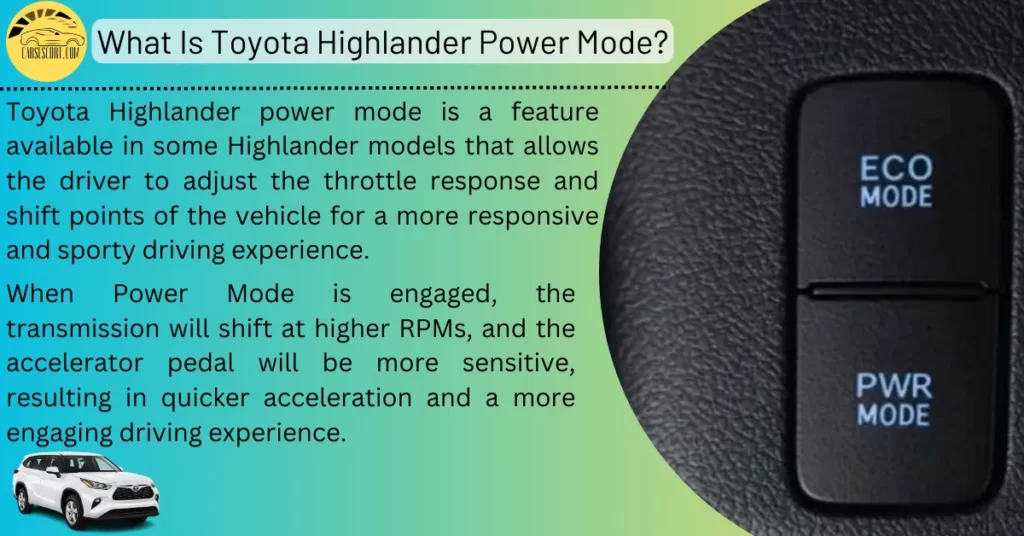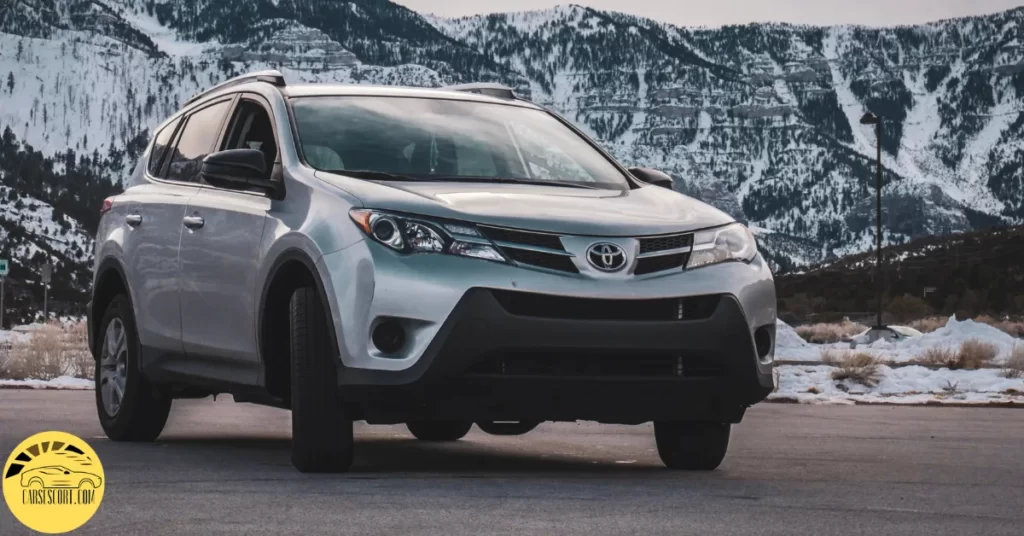The Toyota Highlander is a versatile, stylish-looking midsize SUV a popular choice for families and adventure-seekers.
One of the best standout features of the Toyota Highlander is its Power Mode, which allows drivers to access an extra burst of power when needed. However, using Power Mode can decrease fuel efficiency, as the engine will work harder to deliver more power.
Therefore, it’s recommended to use Power Mode only when necessary and to switch back to Normal Mode for everyday driving.
Key Takeaways
- Toyota Highlander power mode allows the driver to adjust the throttle response and shift points of the vehicle.
- In PWR Mode the transmission will shift at higher RPMs.
- The transmission holds the gears longer, allowing the engine to rev higher before shifting.
- Using the PWR mode frequently reduce fuel efficiency and put additional stress on the vehicle’s components.
What Is Power Mode In Toyota Highlander?
Toyota Highlander power mode is a feature available in some Highlander models that allows the driver to adjust the throttle response and shift points of the vehicle for a more responsive and sporty driving experience.
When Power Mode is engaged, the transmission will shift at higher RPMs, and the accelerator pedal will be more sensitive, resulting in quicker acceleration and a more engaging driving experience.
The increased power output can be helpful when the driver needs to enjoy a sporty feel, merge onto a highway or pass another vehicle quickly.

How Does Power Mode Work in Toyota Highlander?
When the power mode is activated, the vehicle’s engine control unit (ECU) receives a signal from the driver. The ECU then adjusts the throttle response and transmission shift points to provide a more responsive and sporty driving experience by optimizing the internal combustion engine.
In the PWR mode Toyota highlander, the transmission holds the gears longer, allowing the engine to rev higher before shifting and providing a more aggressive acceleration and quicker response.
Benefits Of Toyota Highlander Power Mode
There are several benefits to using the power mode in your Toyota Highlander:
1) Enhanced And Quick Acceleration
The power mode provides a more aggressive acceleration then default driving mode, which can be beneficial in certain situations, such as merging onto a highway or passing another vehicle.
2) Sportier Driving Experience
The power mode makes the vehicle feel more responsive and sporty, which can make driving more fun, and they can enjoy a sportier and more dynamic driving experience.
3) Increased Towing Capacity
If you plan to use your Highlander for towing, the power mode can provide better towing performance by adjusting the throttle response of the gasoline engine and transmission shift points.
Read: Can Someone Tow My Car Without Permission?
4) More Control
With the Toyota Highlander power mode, the driver controls the vehicle’s performance more which can be helpful in certain driving conditions, such as when driving on a winding road or in heavy traffic.

When Should I Use Power Mode?
- Merging onto a highway
- Passing another vehicle
- Driving on steep hills
- Towing a heavy load
- Winding roads or areas with sharp turns.
How To Turn On The Power Mode On A Toyota Highlander?
Turning on the power mode in a Toyota Highlander is a simple process. Here are the steps to follow:
- Make sure the vehicle is in “Drive” mode and is moving at a steady speed.
- Locate the “PWR” button on the center console . It’s typically located near the gear shifter or the driver’s left knee.
- Press the “PWR” button to activate power mode. You should see the light appear on the dashboard, indicating that the power mode is engaged.
- To turn off power mode, press the “PWR” button again. The light on the dashboard will turn off, indicating that the power mode is no longer active.
When Not To Use PWR Mode?
- In slippery or hazardous road conditions
- During heavy traffic or congested areas
- When towing heavy loads
- When driving long distances
Problems With PWR Mode Toyota highlander
The power mode in the Toyota Highlander is designed to enhance the vehicle’s acceleration and provide a more engaging driving experience.
However, as with any feature, some potential issues may arise when using the power mode. Here are a few problems and cons that some Highlander owners have reported:
What are the cons of always driving in Power Mode?
1) Reduced Fuel Economy
Activating power mode forces the engine to work harder, leading to decreased fuel efficiency, and can be a concern for drivers who prioritize fuel economy.
2) Increased Wear and Tear
Using the PWR mode frequently can put additional stress on the vehicle’s components, including the transmission and brakes. Frequent use can increase wear and tear and potentially more frequent repairs.
3) Rough Shifting
Some drivers have reported that the transmission can shift more roughly when the power mode is engaged.
Which can be a less comfortable driving experience and potentially cause damage to the transmission over time.
4) Decreased Lifespan
As with any feature that puts additional stress on the engine, electronic control unit and other components, using the power mode frequently can decrease the overall lifespan of the vehicle.
5) Higher Maintenance Costs
As the vehicle experiences more wear and tear, you may need to perform more frequent maintenance tasks, such as replacing brake pads or changing the transmission fluid.
6) Decreased Resale Value
If you plan to sell the vehicle in the future, excessive use of the power mode can decrease its resale value. Because potential buyers may be wary of purchasing a vehicle subjected to more wear and tear than usual.
Potential Solutions for Power Mode Problems
1) Improve Driving Habits
One of the main reasons for reduced fuel economy and increased wear and tear on the vehicle is aggressive driving.
By driving more calmly and avoiding rapid acceleration and braking, you can help improve the vehicle’s performance and reduce wear on the components as well as road rage.
2) Keep Up With Regular Maintenance
Toyota Highlander requires regular maintenance, such as oil changes and tune-ups, which can help keep the vehicle running smoothly and reduce the risk of problems with the PWR mode and other features.
Follow the recommended maintenance schedule in your vehicle’s owner’s manual.
3) Check For Error Codes
If you’re experiencing rough shifting or other performance issues, there may be an underlying problem with the transmission or other components.
You can check for error codes using a diagnostic tool or take your vehicle to a qualified mechanic or dealership for a diagnosis.
4) Limit Use of PWR Mode
If you’re concerned about fuel economy or wear and tear on the vehicle, it may be best to use the power mode sparingly or only when necessary.
For example, you can turn off power mode and use other driving modes when driving flat roads or towing a light load.
5) Upgrade Components
If you frequently tow heavy loads or drive in hilly terrain, consider upgrading specific components.
You May Also Like To Read:
Why PWR Mode In Toyota Highlander Not Working?
If your power mode in your Toyota Highlander is not working, there could be a few potential reasons:
1) Faulty PWR Button
The PWR button itself could malfunction, preventing the power mode from engaging. Press the button firmly and hold it down for a few seconds to see if it engages.
If not, you may need to have the button replaced.
2) Electrical Issue
There may be an issue with the electrical system preventing the power mode from engaging. The issue could be a blown fuse, a faulty relay, or a wiring issue.
3) Transmission Issue
The power mode relies on the transmission to provide a more aggressive shift pattern. If there is an issue with the transmission, such as low fluid levels or a faulty sensor, the power mode may not engage properly.
4) Vehicle Speed
The power mode may only be available at certain speeds or under certain conditions. For example, it may not be available at very low speeds or when the vehicle is in park or neutral.
Check your owner’s manual for specific requirements for engaging the power mode.
What Is The Difference Between Power Mode And Eco Mode?
PWR Mode
The power mode is designed to provide a more engaging and sporty driving experience. When you engage in power mode, the throttle response increases and the transmission shift points are adjusted to provide a more aggressive driving style.
The Toyota PWR mode can make the vehicle feel more responsive and accelerate more quickly. However, power mode can reduce fuel efficiency and increase vehicle components’ wear and tear.
ECO Mode
Eco mode is designed to prioritize fuel efficiency. When you engage in eco mode, the vehicle’s systems are adjusted to conserve fuel and reduce emissions, including:
- Adjusting the throttle response.
- Adjusting the air conditioning settings.
- Even adjusting the engine output to reduce fuel consumption.
While eco mode can help improve fuel efficiency, it may also make the vehicle feel less responsive and accelerate more slowly.

FAQ
Is the Toyota Highlander faster in Power mode?
Yes, the Toyota Highlander is faster in Power mode as it provides a more aggressive shift pattern and increases the throttle response.
Is it safe to drive my Highlander if the Power Mode is not working?
Yes, it is safe to drive your Highlander if the Power Mode is not working. The vehicle will still operate in normal mode, but you may not have the increased performance and responsiveness that Power mode provides.
Will my Toyota Highlander consume more fuel in PWR mode?
Yes, your Toyota Highlander may consume more fuel in Power mode as it prioritizes performance over fuel efficiency.
Does Toyota Highlander turn off when stopped?
No, the Toyota Highlander does not turn off when stopped. It is equipped with an automatic stop-start system that shuts off the Highlander engine when the vehicle comes to a complete stop and then restarts it when the driver releases the brake pedal.
How long can a Toyota Highlander run?
A Toyota Highlander can run for many years and miles with proper maintenance. The lifespan of a vehicle can vary depending on factors such as usage, maintenance, and driving conditions.
What is PCS on Toyota Highlander?
PCS stands for Pre-Collision System, a safety feature on the Toyota Highlander. It uses cameras and sensors to detect collisions and alerts the driver or applies the brakes to help prevent or mitigate an accident.
Affiliate Disclosure: Cars Escort is a participant in the Amazon Services LLC Associates Program. As an Amazon Associate, we earn from qualifying purchases made through affiliate links on our site. Read Our Disclaimer .

